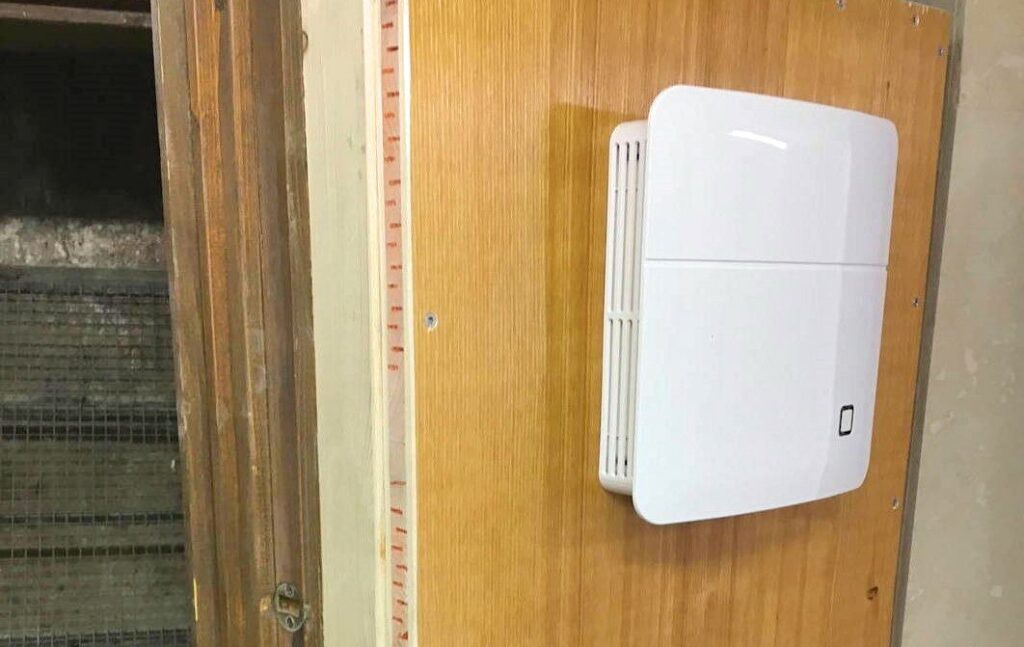Radon ventilation
Would you like to reduce the radon concentration in the basement to a harmless level and improve the indoor climate at the same time? We install intelligent basement ventilation systems.

Homepage › Radon ventilation
Radon ventilation system
According to the Federal Office of Public Health FOPH, inhalation of radon forms [1.] next to smoking, the most common cause of lung cancer and leads to 200 to 300 deaths in Switzerland each year. Since the total revision of the federal radiation protection ordinances on January 1, 2018 [2.] homeowners and builders must comply with certain rules regarding radon in new buildings and renovations.
Thus, in living and recreation rooms, the radon concentration must not exceed the threshold value of 300 becquerels per cubic meter. If the concentration exceeds this value, countermeasures must be taken. An effective and at the same time probably the most cost-effective measure against radon in the house is the installation of a radon ventilation system. [3.]. We install radon ventilation systems. Ask us without obligation.
The radon risk is particularly high in buildings located in an area with high radon contamination (cf. Radon map of the Federation below); in buildings without a continuous concrete foundation and in buildings built before 1960 that have neither moisture protection nor external insulation. In general, the risk of high radon concentration is highest in rooms in contact with the ground.
If you want to find out the radon concentration in your building, you can order dosimeters for radon measurement from a recognized measuring agency, place them in the building for one year and then have them evaluated by the measuring agency [4.].
⇓ «Wegleitung Radon V2.3 02.02.2023» of the Federal Office of Public Health FOPH (German)
Our services
- Radon short-term measurement, if desired
- Installation of radon ventilation
- Re-measurement, if desired
Your advantages
- Advice from experienced civil engineers or building biologists
- Effective and inexpensive protection against radon in the building
- Noticeable improvement of the indoor climate
- Minimizing the risk for mold and moisture damage

Contact us without obligation
Do you have any further questions or may we prepare an offer for you?
Get in touch with us without obligation. We look forward to your inquiry!
Get in touch with us without obligation. We look forward to your inquiry!
Tobias Bayer
Managing Director

Questions & Answers
- General
- Costs
- Functionality
- Radon hazard
- Implementation
What is radon ventilation?
Radon ventilation is an automatic ventilation system with heat recovery that is installed in radon-contaminated cellars. In addition to lowering the radon concentration, it dehumidifies and improves the indoor climate. This can also have a positive effect on the indoor climate on the floors above. The fans are very quiet and economical in consumption.
What is the cost of radon ventilation for the basement?
How does the radon ventilation work?
Who is Haustrocknung.ch?
How much does a radon ventilation system cost?
What is the annual electricity cost of radon ventilation?
The electricity cost of Radon ventilation is CHF 25 per year. Our high quality ventilation systems have multi-stage adjustable operation with humidity or time control and heat recovery, and a maximum power consumption of 6 watts.
How does radon ventilation affect heating costs?
What are the maintenance costs and expenses?
How does radon ventilation work?
How effective is ventilation in reducing radon concentrations?
According to the Federal Office of Public Health FOPH ventilation of cellars is an effective measure for reducing radon concentrations. To be on the safe side, a radon measurement should be carried out following the installation of basement ventilation. In our experience, basement ventilation provides effective protection against radon and is also the most cost-effective measure against radon in the home.
How is the ventilation controlled?
Basement ventilation basically controls itself via e.g. the humidity sensors. Alternatively, the ventilation unit can also be operated via remote control.
What can the radon ventilation do?
Why can radon be dangerous in the basement?
Radon is a radioactive gas that has been shown to increase the risk of lung cancer when inhaled. The gas is produced by the natural decay of uranium, which is found in soil and rocks. It enters the basement through cracks and leaks in the soil, where it accumulates if ventilation is inadequate.
Which buildings are at increased risk of radon?
How can I measure the radon concentration in the house?
According to the Federal Office of Public Health FOPH radon can be measured easily and inexpensively by means of so-called «dosimeters», which you can order from a recognized radon measuring station. The measurement should be carried out in addition to the basement in two separate living spaces with longer residence times, whereby the measurement period must extend over at least three months during the heating period.
What radon concentrations are considered safe or harmful?
The Federal Radiation Protection Ordinance has stipulated a reference value of 300 becquerels per cubic meter for radon concentrations in living and recreation rooms since 2018. Concentrations of the noble gas that are below this threshold are considered harmless. However, inhalation of radon should be avoided at all costs.
When is radon ventilation required?
Where do you install the radon ventilation?
The ventilation units are very quiet and can be installed both in the cellar and in the living room. They can be installed in windows, light wells or by drilling a core hole at a suitable point in the outside wall. After inspecting the rooms concerned, we will make you a proposal for the installation of the ventilation system. Contact us without obligation.
What should be considered in terms of installation?
How long does it take to install the ventilation?
Radon ventilation installation usually takes between half a day and a full day.
Sources
- Federal Office of Public Health FOPH - Radon causes lung cancer
- Federal Office of Public Health FOPH - Total revision of the ordinances in radiation protection
- Federal Office of Public Health FOPH - Radon and energy measures in buildings (German)
- Federal Office of Public Health FOPH - Radon concentration measurement
- Federal Office of Public Health FOPH - Radon map of Switzerland